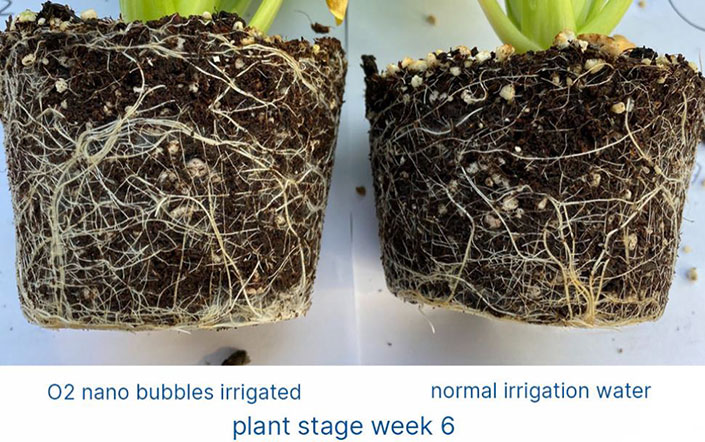
Foreport was set up in 1979 with their head office in Taipei Taiwan. Foreport specializes in import and export of horticulture products. This includes seeds, plants, and bulbs as well as related material and equipment.
Besides service they give to Taiwanese growers by their technical team, they also have three nurseries in Taoyuan, Puli, and Chin Jing. The primary function of the greenhouses is to do trials for new varieties, produce seedlings, rooted cuttings, store bulbs and related materials.
In December 2019 till February 2020, Foreport did commercial nanobubble trials with young plants. The purpose was to show the power of the Turbiti submersible nanobubble generators to their customers.
Nanobubble Research
Taiwan is known for its hot and humid climate. The months from December through to February are different in terms of light and temperature. During this period, all plant growth is determined by the amount of natural light.
All crops under cultivation slow down in development during the winter season. Even though natural light is the limiting factor in growth we could see significant differences in crop performance of plants treated with nanobubble oxygen water and the crop grown with normal water.

The differences in growth can be seen by the size of the plants in the photo above. The earlier photo shows the difference in root growth to that point of plant development.
Research setup
- Cultivation location west of Taipei
- Water tank is 15m3
- In the water tank submerged one Turbiti 737 submersible nanobubble mixer
- Trial period 5 Dec 2019- 15 Feb 2020
- Seedling period: 2019/12/04-2019/12/31
- Transplanted in 3” pots for 4 weeks
- Transplanting period: 2020/01/01-2020/02/15
- Supervised by Foreport and a government research institute
For 15 tons of water the Turbiti submersible unit is runs for 4 hours. Incoming water measuring 6.5 ppm of dissolved oxygen. The DO was set on 20 ppm in the tank, with a loss of a little less than 10% through the water system this translated to 18.3 ppm in the greenhouse at the plant roots. Irrigation recipe had the normal intervals during cultivation.

Research observations and conclusions
- Nanobubbles treated seedlings, as is the expectation, will have a higher survival rate during hot summers because they developed a stronger root system
- After transplanting, in the 3rd week, the treated plants are bigger than without treatment
- The harvested vegetable in 6th week is about 25-30% heavier than without treatment

See below table showing differences between nanobubbles vs normal water on height, number of leaves and fresh weight.
Results cultivating vegetables with and without O2 nanobubble treatment after transplant 6 weeks:
(Equipment used Turbiti Submersible UFB Generator and Oxygen Concentrator)
| Product | Treatment | Notes | Height (cm) | No of leaves | Fresh Weight (g) |
|---|---|---|---|---|---|
| Brassica rapa var. perviridis | Nanobubbles | O2-O2 | 16.4 | 8.5 | 25.9 |
| 小松 * | Normal | CK-CK | 15.3 | 8.4 | 20.4 |
| Brassica chinensis Linn | Nanobubbles | O2-O2 | 12.0 | 12.1 | 31.2 |
| 青江菜* spoon cabbage | Normal | CK-CK | 10.4 | 11.9 | 24.6 |
| Lettuce “black leaf” | Nanobubbles | O2-O2 | 14.5 | 8.0 | 26.6 |
| 黑葉* | Normal | CK-CK | 12.6 | 7.9 | 20.4 |
Notes:
* this information is in Chinese and is copied as provided in the table from Foreport. We are not aware of the corresponding English word.
The table above is as supplied by Foreport where the same equipment as the Turbiti Submersible Nanobubble Generator coupled to a Oxygen Concentrator was used.